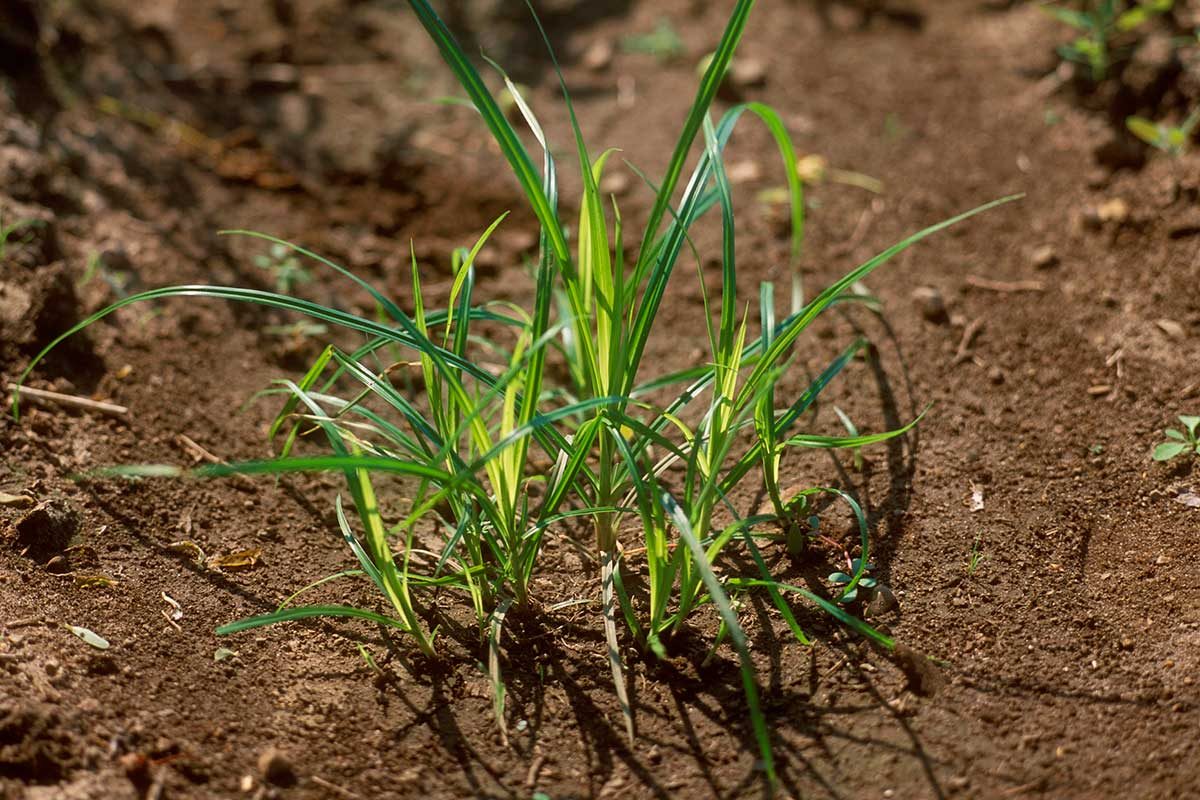If you don't know what nutsedge looks like, you're not alone. This troublesome lawn weed is not easy to spot unless you know what to look for.

Nutsedge: What It Looks Like and the Best Ways to Control It

An aggressive lawn weed that can be a homeowner’s nightmare, nutsedge (also called nut grass or water grass) can be hard to identify, especially if you’re not sure what nutsedge looks like. Often by the time you figure out what it is, it’s too late. Learn what nutsedge is, how to identify it in your lawn, and explore DIY removal methods with tips from Joe Churchill, senior turf specialist at Reinders, Inc.
On This Page
What Is Nutsedge?
Nutsedge is a persistent turf-grass weed that grows in warm temperatures, so it’s most prominent during the spring and summer months. In southern states such as Florida, nutsedge can be an issue year-round. It’s also one of the most difficult weeds to control, which is why controlling it in lawns requires consistent effort and strategy.
The two most common varieties of nutsedge in the U.S. are yellow nutsedge and purple nutsedge—named for the color of the flowers at the end of their stems. You can usually find these flowers blooming in the sunniest areas of the lawn.
If nutsedge were a bug, it would be categorized as “social” because it grows in large colonies, forming an extensive root system that can reach as deep as four feet.
How to Identify Nutsedge In Your Lawn
While regular blades of grass are rounded, nutsedge has a distinct “V” shape with three sides and three points, similar to a triangle.
If you pluck a specimen out of the ground, you’ll notice the roots of nutsedge (called rhizomes) grow horizontally, fanning out to form new sedges. At the end of the roots are small, round tubers, known as nutlets.
“Nutsedge is oftentimes found in wet shaded areas,” says Churchill. “It’s a bunch-type weed that can grow a bit taller than surrounding grasses and is usually darker green and has a shiny leaf surface.”
- Pro tip: When inspecting your lawn for the weed, remember the phrase “sedges have edges” to help you identify it correctly.
Key differences between nutsedge and grass
- Botanical family: According to Oregon State University’s Forage Information System, grasses belong to the Poaceae family and typically complete their life cycle seasonally. Meanwhile, nutsedge is part of the sedge family (Cyperaceae) and tends to grow year-round in warmer climates.
- Leaf and stem structure: Grass blades are usually flat and rounded, while nutsedge has a peculiar V-shaped, three-sided stem and shinier leaves.
- Growth pattern: Grass grows in clumps or spreads via runners. On the other hand, nutsedge forms dense colonies using underground rhizomes and nutlets that make it harder to eliminate.
Is Nutsedge Safe?
Nutsedge is not toxic or poisonous to the touch or to ingest. Many dogs eat nutsedge for the same reason they eat grass — they have an upset stomach or they just like the taste.
Though nutsedge is not dangerous, it’s bad for your lawn because it can quickly choke out healthy grass and eventually take over an otherwise well-maintained lawn.
DIY Methods to Remove Nutsedge
Nutsedge is a perennial weed that can live up to two years. If not dealt with, it will return year after year. The roots eventually become drought tolerant, so once established in your lawn it’s extremely difficult to eradicate. This is why it’s important to control nutsedge in lawns right away.
Here are a few things you can do to get rid of nutsedge:
- If you catch it early, pull nutsedge out of your lawn by hand.
- Treat with a post-emergent herbicide specifically for the nutsedge you have (yellow, purple or both).
“Nutsedge is a different type of weed and requires a special active ingredient,” Churchill says. The most common is halosulfuron. Popular brand names are Sedgehammer and ProSedge. “This [active ingredient] is specific to killing nutsedge and really doesn’t work well on any other type of weed,” he says. Many experts aren’t convinced that natural weedkillers for nutsedge work well. Whatever herbicide treatment you choose, be sure to follow all label instructions carefully.
How to Prevent Nutsedge
If you don’t have nutsedge at the moment, taking precautions now to prevent it from taking hold in your yard will help you avoid problems down the road. As problematic as nutsedge can be, controlling it in lawns is possible with consistent care and preventive measures.
- Make sure your yard is well-drained; nutsedge thrives in moist soil.
- Keep your lawn thick by reseeding and feeding it. Healthy grass discourages nutsedge.
- Cut your lawn on the mower’s highest setting. Short grass encourages nutsedge.
- Don’t introduce new plantings/soil without checking for nutsedge tubers first.
Tip: If at any time you feel as though you’re losing the battle against nutsedge, don’t hesitate to call in a local lawn professional for help.
FAQs
What are the signs of nutsedge in a lawn?
The most obvious signs include triangular stems with three distinct edges, faster growth than surrounding grass and a V-shaped leaf arrangement. After mowing, nutsedge will rebound quickly, often standing taller than your lawn grass within days.
Why does nutsedge keep coming back after treatment?
Nutsedge is persistent because a single plant can produce hundreds of nutlets that remain viable in soil for years. If even one nutlet remains after treatment, new plants will emerge. Multiple treatments and preventive measures are often necessary for complete control.
About the Expert
- Joe Churchill is a senior turf specialist at Reinders, Inc. With 40 years in the green industry, he’s helped professionals across lawn care, golf and sports turf grow healthier, more sustainable turf through smart maintenance practices and reduced reliance on pesticides and fertilizers.
Sources:
- Reinders, Inc.: “Reinders, Inc. home page”
- Nufarm: “Prosedge® Selective Herbicide2”
- Oregon State University’s Forage Information System: “Grasses are very common but very important”




















